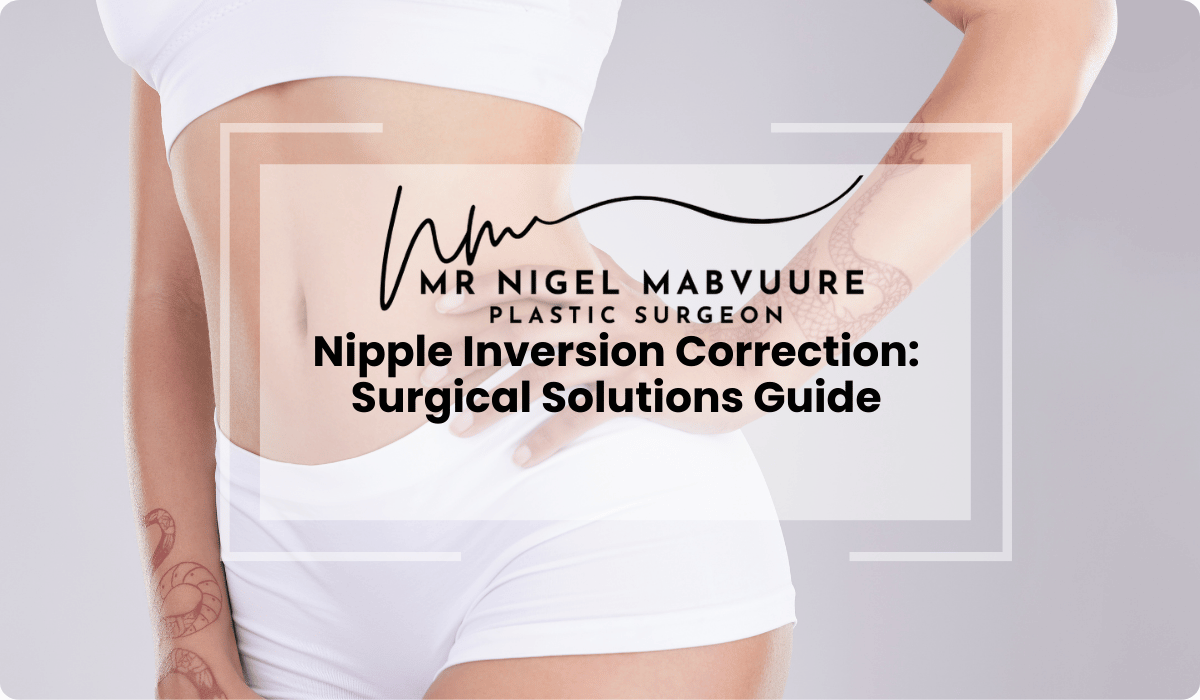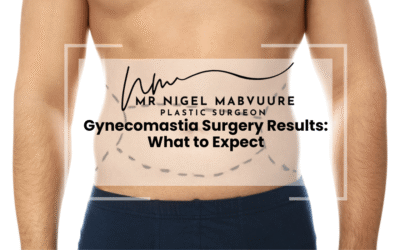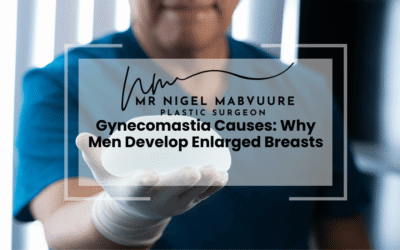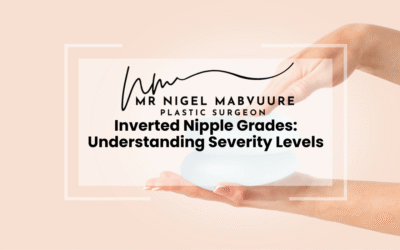- Nipple inversion affects 10-20% of women in the UK and is classified into three grades of severity, with Grade 3 being the most severe and typically requiring surgical intervention.
- Non-surgical treatments like the Hoffman Technique and suction devices may help with Grade 1 inversion but rarely provide permanent results for moderate to severe cases.
- Surgical correction techniques include duct-preserving methods (which maintain breastfeeding ability) and duct-dividing procedures (which offer higher success rates but eliminate breastfeeding capability).
- Recovery is typically straightforward, with most patients returning to light activities within 1-2 days and achieving full recovery within 4-6 weeks.
- Long-term success rates range from 70-95% depending on the technique used, with most patients experiencing permanent correction after proper healing.
- When choosing a surgeon, look for board certification, specific experience with nipple procedures, and a portfolio of before-and-after results similar to your condition.
Table of Contents
- Understanding Nipple Inversion: Causes and Classification
- Non-Surgical Treatments for Inverted Nipples: Do They Work?
- Surgical Techniques for Nipple Inversion Correction
- What to Expect During Inverted Nipple Surgery
- Recovery and Aftercare Following Nipple Correction
- Will Nipple Correction Surgery Affect Breastfeeding?
- Long-Term Results: Permanence and Success Rates
- Choosing the Right Surgeon for Nipple Inversion Treatment
Understanding Nipple Inversion: Causes and Classification
Nipple inversion affects approximately 10-20% of women in the UK, yet despite its prevalence, many remain unaware of the available treatment options. Inverted nipples occur when the nipple retracts inward into the breast tissue rather than projecting outward. This condition can be present from birth (congenital inverted nipples) or develop later in life (acquired nipple inversion).
Medical professionals classify nipple inversion into three distinct grades based on severity:
- Grade 1: Mild inversion where the nipple can be manually pulled out and may temporarily remain everted. Breastfeeding is typically possible, and the condition may resolve naturally during pregnancy or arousal.
- Grade 2: Moderate inversion where the nipple can be pulled out but retracts quickly. Breastfeeding may be challenging but sometimes possible. Manual techniques rarely provide lasting correction.
- Grade 3: Severe inversion where the nipple is deeply retracted and difficult to pull out manually. Breastfeeding is usually not possible, and surgical intervention is typically the only effective solution.
The primary causes of nipple inversion include:
- Congenital factors: Short milk ducts or tight connective tissue that tethers the nipple to the underlying breast tissue.
- Mammary duct ectasia: Inflammation and blockage of milk ducts.
- Mastitis: Breast tissue inflammation, often associated with breastfeeding.
- Breast surgery: Previous procedures may cause scarring that pulls the nipple inward.
- Breast cancer: Though rare, sudden nipple inversion can be a warning sign requiring immediate medical evaluation.
Understanding the specific grade and cause of nipple inversion is crucial for determining the most appropriate treatment approach. While many individuals seek correction for aesthetic reasons, others experience physical discomfort, hygiene challenges, or difficulties with breastfeeding that motivate them to pursue treatment.
Non-Surgical Treatments for Inverted Nipples: Do They Work?
Before considering surgical intervention, many patients inquire about non-surgical options for nipple inversion treatment. These approaches are most effective for Grade 1 inversion and occasionally Grade 2, but rarely provide lasting results for severe cases.
Hoffman Technique: This manual manipulation method involves placing thumbs on opposite sides of the areola and gently pulling outward. The technique should be performed several times daily for weeks or months. While some patients report improvement, results are typically temporary and require ongoing maintenance.
Suction Devices: Specialised devices like the Niplette™ create gentle vacuum pressure to gradually draw the nipple outward. Clinical studies show moderate success rates of 30-50% for Grade 1 inversion when used consistently for 3-6 months. However, once discontinued, many patients experience regression, particularly with more severe grades of inversion.
Breast Shells: These dome-shaped devices apply continuous gentle pressure around the areola. Originally designed for breastfeeding mothers, they may help with mild inversion but rarely provide permanent correction. They work by applying pressure to the areola while creating space for the nipple to protrude.
Piercings: Some individuals opt for nipple piercings as a non-medical approach. While the jewellery can physically prevent the nipple from inverting, this method carries risks of infection and scarring. It’s not recommended as a medical solution and should only be performed by qualified professionals if chosen.
At All Skin Surgery, we evaluate each patient’s specific condition to determine if non-surgical approaches might be effective. For Grade 1 inversion, we often recommend trying these conservative methods before considering surgery. However, patients should maintain realistic expectations—while non-surgical techniques may provide temporary improvement, they rarely offer the permanent correction that surgical intervention can achieve, particularly for moderate to severe cases.
Surgical Techniques for Nipple Inversion Correction
Surgical correction remains the most effective and permanent solution for inverted nipples, particularly for Grade 2 and Grade 3 cases. Modern nipple eversion surgery techniques have evolved significantly, offering high success rates with minimal scarring. The primary surgical approaches include:
Parachute Technique: This minimally invasive procedure involves making a small incision at the base of the nipple, releasing the constricting ducts and fibrous bands, then using purse-string sutures to maintain the nipple’s projection. The technique derives its name from the way the sutures resemble parachute strings supporting the nipple structure. This method is particularly effective for Grade 1 and some Grade 2 inversions.
Duct-Preserving Technique: Ideal for women who wish to preserve breastfeeding capability, this approach carefully releases only the fibrous bands causing inversion while preserving the milk ducts. Small incisions are made at the nipple base, and dissection is performed with precision to maintain ductal integrity. While offering a good balance between correction and function, this technique may have slightly lower success rates for severe inversion.
Duct-Dividing Technique: For severe Grade 3 inversion, complete division of the milk ducts may be necessary to achieve full correction. This technique offers the highest success rate and most dramatic improvement but eliminates the possibility of breastfeeding. The procedure involves more extensive release of the tethering structures and often incorporates tissue rearrangement to provide long-term support to the newly everted nipple.
Dermal Flap Technique: This advanced approach uses small flaps of dermal tissue from beneath the nipple to create a supportive structure that maintains projection. The flaps act as internal scaffolding, reducing the risk of recurrence. This technique is particularly valuable for cases with significant tissue deficiency or previous failed corrections.
The choice of surgical technique depends on several factors, including the grade of inversion, whether breastfeeding preservation is desired, and the patient’s anatomy. During consultation, our specialist surgeons thoroughly assess each case to recommend the most appropriate approach that balances aesthetic outcomes with functional considerations. Most nipple inversion correction procedures are performed under local anaesthesia as outpatient procedures, typically taking 30-60 minutes per nipple.
What to Expect During Inverted Nipple Surgery
Understanding the surgical process for nipple inversion correction can help alleviate anxiety and ensure you’re properly prepared. The procedure is typically performed as an outpatient treatment under local anaesthesia, meaning you’ll remain awake but comfortable throughout.
Pre-Surgical Consultation: Before scheduling surgery, you’ll meet with your surgeon to discuss your medical history, examine your nipple inversion, and determine the most appropriate surgical technique. This is the ideal time to ask questions about expected outcomes and express any concerns about the procedure.
Preparation: On the day of surgery, the breast area will be cleansed with an antiseptic solution. Local anaesthesia will be administered around the nipple and areola, which may cause brief discomfort but will quickly numb the area. Some patients opt for oral sedation to help them relax during the procedure.
Surgical Procedure: The actual nipple correction surgery typically takes 30-60 minutes per nipple. Your surgeon will make small incisions, usually at the base of the nipple where it meets the areola, minimising visible scarring. Through these incisions, the constricting ducts and fibrous bands will be released using precise microsurgical techniques. Depending on the chosen method, supporting sutures will be placed to maintain the nipple’s new projected position.
Is the procedure painful? Most patients report minimal discomfort during the surgery due to effective local anaesthesia. Some describe feeling pressure or tugging sensations, but not pain. Post-operative discomfort is typically mild and well-managed with over-the-counter pain relievers.
Immediate Results: You’ll notice the correction immediately after surgery, with your nipples appearing everted. However, some temporary swelling and sensitivity are normal. A protective dressing will be applied, and you’ll receive specific instructions for the initial 24-48 hours of recovery.
Same-Day Return Home: As an outpatient procedure, you’ll be able to return home the same day. We recommend having someone accompany you, though many patients feel well enough to drive themselves if necessary. The entire process from arrival to departure typically takes 2-3 hours, including preparation and recovery time.
Throughout the procedure, our surgical team prioritises both your physical comfort and emotional wellbeing, ensuring a dignified experience with clear communication at every stage.
Recovery and Aftercare Following Nipple Correction
Proper aftercare following nipple inversion correction is essential for optimal healing and long-lasting results. Most patients are pleasantly surprised by the relatively straightforward recovery process, which typically follows this timeline:
First 24-48 Hours: Immediately after surgery, the treated area will be covered with a protective dressing. You may experience mild discomfort, swelling, and sensitivity, which can be managed with over-the-counter pain medication such as paracetamol. Cold compresses applied intermittently can help reduce swelling, but avoid direct contact with the surgical site.
First Week: Most patients can return to desk jobs and light activities within 1-2 days. The initial dressings will be removed or changed at your first follow-up appointment, typically scheduled 3-5 days post-surgery. Showering is usually permitted after 48 hours, but the nipple area should be gently patted dry rather than rubbed. Any non-dissolvable stitches will remain in place.
Weeks 1-2: During this period, you should continue to wear a supportive, non-underwired bra day and night to protect the healing nipples. Avoid strenuous exercise, heavy lifting, and activities that could cause impact to the chest. Some patients notice temporary changes in nipple sensation, ranging from heightened sensitivity to numbness, which typically resolves as healing progresses.
Weeks 2-4: Any remaining non-dissolvable sutures will be removed around the two-week mark. Most patients can gradually resume normal activities, including more vigorous exercise, though direct pressure on the nipples should still be avoided. The appearance of the nipples continues to improve as swelling subsides.
Key aftercare instructions include:
- Keep the surgical site clean and dry
- Take antibiotics if prescribed to prevent infection
- Apply any recommended ointments as directed
- Avoid smoking, which can impair healing
- Refrain from sexual activity involving the breasts for at least 3-4 weeks
- Attend all scheduled follow-up appointments
Most patients achieve full recovery within 4-6 weeks, though subtle improvements in appearance may continue for several months as the tissues fully settle. Our clinical team provides comprehensive aftercare support throughout your recovery journey, with direct access to your surgeon should any concerns arise during the healing process.
Will Nipple Correction Surgery Affect Breastfeeding?
The potential impact on breastfeeding capability is one of the most important considerations for women contemplating nipple inversion correction. The effect largely depends on the surgical technique employed and should be thoroughly discussed during your consultation.
Duct-Preserving Techniques: For women who wish to preserve breastfeeding ability, duct-preserving surgical methods offer the best option. These techniques carefully release the fibrous bands causing inversion while maintaining the integrity of the milk ducts. Clinical studies indicate that approximately 80-85% of women who undergo duct-preserving procedures retain some breastfeeding capability, though the volume of milk production may be reduced compared to pre-surgery levels.
Duct-Dividing Techniques: In cases of severe Grade 3 inversion, complete division of the milk ducts may be necessary to achieve full correction and prevent recurrence. This approach offers excellent aesthetic results but eliminates the possibility of breastfeeding. For women who have completed their families or do not plan to breastfeed, this limitation may be acceptable in exchange for definitive correction.
Partial Preservation: Some surgical approaches fall between these two extremes, preserving some ducts while dividing others. This compromise may allow limited breastfeeding while still providing good aesthetic correction. The degree of preservation possible depends on individual anatomy and the severity of inversion.
Important considerations for future mothers:
- If breastfeeding is important to you, explicitly discuss this with your surgeon before proceeding
- Consider delaying surgery until after completing your family if breastfeeding is a priority
- Even with duct-preserving techniques, supplemental feeding may be necessary
- Some women find that pregnancy itself temporarily or permanently corrects mild nipple inversion
At our clinic, we take a personalised approach to each patient’s needs and future plans. For younger women who have not yet had children, we often recommend duct-preserving techniques even if they offer slightly less dramatic correction. For those with severe inversion who have completed their families, duct-dividing techniques may provide optimal aesthetic results without functional concerns.
During your consultation, we’ll thoroughly explain the available options and help you make an informed decision that aligns with both your aesthetic goals and future family plans.
Long-Term Results: Permanence and Success Rates
Patients considering nipple inversion correction naturally want to know whether the results will last. The good news is that modern surgical techniques offer excellent long-term outcomes with high satisfaction rates when performed by experienced specialists.
Success Rates: Clinical studies demonstrate that surgical correction of inverted nipples has an overall success rate of 85-95%, with the highest success rates observed in procedures that divide the milk ducts. Duct-preserving techniques have slightly lower but still impressive success rates of 70-85%. These statistics reflect complete correction with no recurrence after the healing process is complete.
Frequently Asked Questions
How much does inverted nipple correction surgery cost in the UK?
Inverted nipple correction surgery in the UK typically costs between £1,500 and £3,000 for both nipples. The exact price depends on several factors including the severity of inversion, the surgical technique required, the surgeon’s experience, and the clinic location. Some clinics offer finance options with monthly payment plans. This procedure is rarely covered by the NHS unless it’s causing significant medical issues, as it’s generally considered cosmetic.
Is inverted nipple correction surgery painful?
Most patients report minimal discomfort during inverted nipple surgery due to effective local anaesthesia. During the procedure, you may feel pressure or tugging sensations but not pain. Post-operative discomfort is typically mild and well-managed with over-the-counter pain relievers like paracetamol. Most patients describe the recovery as involving mild tenderness for 3-5 days rather than significant pain.
How long does it take to recover from nipple correction surgery?
Recovery from nipple correction surgery is relatively quick. Most patients can return to desk jobs and light activities within 1-2 days. The initial healing period lasts about 1-2 weeks, during which you should wear a supportive bra and avoid strenuous exercise. Complete healing with final results typically occurs within 4-6 weeks, though you may notice continued subtle improvements for several months as tissues fully settle.
Can inverted nipples correct themselves naturally?
Grade 1 (mild) inverted nipples sometimes correct themselves naturally, particularly during pregnancy, breastfeeding, or sexual arousal. Temperature changes can also temporarily cause eversion in mild cases. However, Grade 2 and Grade 3 inversions rarely resolve without intervention. Non-surgical methods like the Hoffman Technique or suction devices may help with mild inversion but typically require consistent long-term use and often provide only temporary results.
Will I lose nipple sensation after inverted nipple surgery?
Most patients retain normal nipple sensation after correction surgery. Temporary changes in sensation—ranging from heightened sensitivity to numbness—are common during the healing process but typically resolve within 3-6 months. Studies show that over 90% of patients report normal sensation within one year. The risk of permanent sensation changes is approximately 5-10% and is higher with more invasive techniques used for severe inversion.
Can inverted nipples return after surgical correction?
The recurrence rate after surgical nipple correction is low, approximately 5-15% depending on the technique used. Duct-dividing techniques have the lowest recurrence rates (under 5%) but impact breastfeeding ability. Duct-preserving techniques have slightly higher recurrence rates (10-15%) but maintain breastfeeding potential. Factors that increase recurrence risk include severe (Grade 3) initial inversion, poor healing, and post-operative complications like infection.
Is nipple correction surgery performed under general or local anaesthesia?
Nipple correction surgery is typically performed under local anaesthesia, meaning you’ll remain awake but the area will be completely numb. The procedure usually takes 30-60 minutes per nipple and is done on an outpatient basis, allowing you to return home the same day. Some patients opt for additional oral sedation to help them relax during the procedure. General anaesthesia is rarely necessary unless the correction is being performed alongside other breast procedures.




